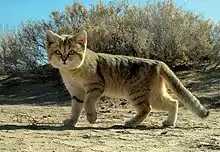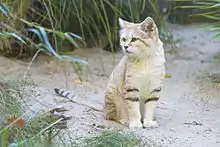Felis margarita thinobia
Felis margarita thinobia, known as the Turkestan sand cat, Arabian sand cat, and Pakistan sand cat, is a sand cat subspecies native to deserts in the Arabian Peninsula, Iran, Pakistan and Central Asia.[1][2]
| Felis margarita thinobia | |
|---|---|
 | |
| Sand cat photographed in Iran | |
| Scientific classification | |
| Domain: | Eukaryota |
| Kingdom: | Animalia |
| Phylum: | Chordata |
| Class: | Mammalia |
| Order: | Carnivora |
| Suborder: | Feliformia |
| Family: | Felidae |
| Subfamily: | Felinae |
| Genus: | Felis |
| Species: | |
| Subspecies: | F. m. thinobia |
| Trinomial name | |
| Felis margarita thinobia (Ognev, 1926) | |
| Synonyms[1] | |
Taxonomy
In 1926, Russian zoologist Sergey Ognev described a sand cat collected in the Karakum Desert in Turkmenistan under the name Eremaelurus thinobius.[3] In 1938, British zoologist Reginald Innes Pocock considered this specimen a species under the name Felis thinobius.[4] Later he considered it a subspecies of the sand cat, which to date is widely recognised.[5][2][6][7]
In 1974, F. m. scheffeli was described based on seven specimens from Pakistan's Nushki desert.[8] In 1976, F. m. harrisoni was described based on a single specimen captured in Oman.[9]
In 2017, the Cat Classification Task Force of the Cat Specialist Group subordinated both F. m. harrisoni and F. m. scheffeli to F. m. thinobia.[1]
Characteristics
Sand cat specimens collected in the Karakum Desert in Turkestan were described as darker and greyer in fur colour than the Saharan sand cat (F. m. margarita), with less pronounced markings and only 2–3 tail rings. Specimens from Pakistan were more strongly marked, had shorter carnassials and a less expanded occiput than ones from Turkestan.[9] Later studies confirmed that F. m. thinobia is larger in size with greyer fur and fewer markings than F. m. margarita.[1]
Distribution and habitat
In the Arabian Peninsula, sand cats were recorded in Saudi Arabia's Mahazat as-Sayd Protected Area and in the country's Najdi region.[10][11] In the United Arab Emirates, sand cats were observed in Al Ain Region, Abu Dhabi, and recorded by camera-traps in Baynouna Protected Area.[12][13] A record in Oman's Umm al Samim area dates to the 1970s.[9]
In the Near East, sand cats were radio-collared and tracked in Israel's Arabah Valley, observed in a Jordanian desert, in the central Syrian desert near Palmyra, and captured in Iraq's Najaf desert.[14][15][16][17][18] In Iran, sand cats were recorded in sandy deserts of Abbas'abad Wildlife Reserve, Kavir National Park, Petergan Rural District, and in Sistan and Baluchestan Province.[19][20] In Pakistan, sand cats were captured between the early 1960s and mid 1970s in the Chagai Hills, an extremely arid area comprising rolling sand dunes and stony plains at an elevation of about 1,200 m (3,900 ft).[21]
In Central Asia, sand cats were captured in the east of the Karakum Desert in the early 1920s, and in the 1950s also in Turkmenistan, Uzbekistan and Kazakhstan for the fur trade.[3][22] In the southern Kyzylkum Desert, sand cats were recorded by camera-traps in 2013.[23]
Conservation

In 2003, the status of the Pakistan sand cat population was assessed as Critically Endangered during a workshop for the national 'Red List of Pakistan's Mammals'.[24] However, a survey targeting the sand cat population in the country has not been carried out since the 1960s.[25]
References
- Kitchener, A. C.; Breitenmoser-Würsten, C.; Eizirik, E.; Gentry, A.; Werdelin, L.; Wilting, A.; Yamaguchi, N.; Abramov, A. V.; Christiansen, P.; Driscoll, C.; Duckworth, J. W.; Johnson, W.; Luo, S.-J.; Meijaard, E.; O'Donoghue, P.; Sanderson, J.; Seymour, K.; Bruford, M.; Groves, C.; Hoffmann, M.; Nowell, K.; Timmons, Z.; Tobe, S. (2017). "A revised taxonomy of the Felidae: The final report of the Cat Classification Task Force of the IUCN Cat Specialist Group" (PDF). Cat News (Special Issue 11): 14–15.
- Sliwa, A. (2009). "Sand Cat Felis margarita". In Wilson, D. E.; Mittermeier, R. A. (eds.). Handbook of the Mammals of the World, Volume 1: Order Carnivora. Barcelona: Lynx Edicions.
- Ognev, S. (1926). "A new genus and species of cat from the Transcaspian region". Annuaire du Musée Zoologique Académie des Sciences USSR. 27: 356–362.
- Pocock, R.I. (1938). "The Algerian Sand Cat (Felis margarita Loche)". Proceedings of the Zoological Society of London. B108 (1): 41–46. doi:10.1111/j.1096-3642.1938.tb00021.x.
- Pocock, R. I. (1951). Catalogue of the genus Felis. London: British Museum (Natural History).
- Cole, F.R.; Wilson, D.E. (2015). "Felis margarita (Carnivora: Felidae)" (PDF). Mammalian Species. 47 (924): 63–77. doi:10.1093/mspecies/sev007.
- Sliwa, A. (2013). "Felis margarita Sand Cat". In Kingdon, J.; Happold, D. (eds.). Mammals of Africa, Volume V: Carnivores, Pangolins, Equids and Rhinoceroses. London: Bloomsbury Publishing. pp. 199–202.
- Hemmer, H. (1974). "Studien zur Systematik und Biologie der Sandkatze (Felis margarita Loche, 1858)" [Studies on the systematics and biology of the sand cat]. Zeitschrift des Kölner Zoo (in German). 17 (1): 11–20.
- Hemmer, H.; Grubb, P.; Groves, C. P. (1976). "Notes on the sand cat, Felis margarita Loche 1858" (PDF). Zeitschrift für Säugetierkunde. 41: 286–303.
- Ostrowski, S.; Van Vuuren, M.; Lenain, D. M.; Durand, A. (2003). "A serologic survey of wild felids from central west Saudi Arabia". Journal of Wildlife Diseases. 39 (3): 696–701. doi:10.7589/0090-3558-39.3.696. PMID 14567233. S2CID 25416007.
- Sher Shah, M.; Cunningham, P. (2008). "Fences as a threat to Sand cats Felis margarita Loche, 1958, in Saudi Arabia". Zoology in the Middle East. 42: 99–101.
- Cunningham, P. (2002). "Status of the Sand Cat, Felis margarita, in the United Arab Emirates". Zoology in the Middle East. 25: 9–14. doi:10.1080/09397140.2002.10637898. S2CID 83659961.
- Ahmed, S.; Al Zaabi, R.; Soorae, P.; Shah, J. N.; Al Hammadi, E.; Pusey, R.; Al Dhaheri, S. (2016). "Rediscovering the Arabian sand cat (Felis margarita harrisoni) after a gap of 10 years using camera traps in the Western Region of Abu Dhabi, United Arab Emirates". European Journal of Wildlife Research. 62 (5): 627–631. doi:10.1007/s10344-016-1035-8. S2CID 779635.
- Abbadi, M. (1991). "Israel' s elusive feline: Sand Cats". Israel Land and Nature. 16 (3): 111–115.
- Hemmer, H. (1978). "Nachweis der Sandkatze (Felis margarita harrisoni Hemmer, Grubb und Groves, 1976) in Jordanien". Zeitschrift für Säugetierkunde. 43: 62–64.
- Bunaian, F.; Mashaqbeh, S.; Yousef, M.; Buduri, A.; Amr, Z. S. (1998). "A new record of the Sand Cat, Felis margarita, from Jordan". Zoology in the Middle East. 16: 5–7. doi:10.1080/09397140.1998.10637748.
- Serra, G.; Abdallah, M. S.; Al Quaim, G. (2007). "Occurrence of Ruppell's fox Vulpes rueppelli and Sand cat Felis margarita in Syria" (PDF). Zoology in the Middle East. 42: 99–101. doi:10.1080/09397140.2007.10638252. S2CID 84492343.
- Mohammad, M. K.; Lahony, S. R.; Al-Rammahi, H. M. (2013). "First record of the Sand Cat, Felis margarita Loche, 1858 (Mammalia: Carnivora, Felidae), from Iraq". Zoology in the Middle East. 59 (4): 358–359. doi:10.1080/09397140.2013.868144. S2CID 85019590.
- Ghadirian, T.; Akbari, H.; Besmeli, M.; Ghoddousi, A.; Hamidi, A. K. & Dehkordi, M. E. (2016). "Sand cat in Iran – present status, distribution and conservation challenges" (PDF). Cat News (Special Issue 10): 56–59.
- Ghafaripour, S.; Naderi, M. & Rezaei, H. R. (2017). "Investigating abundance, density and potential threats of Sand Cat in the South-Eastern parts of Iran" (PDF). Journal of Wildlife and Biodiversity. 1 (1): 47−55.
- Roberts, T. (1977). "Felis margarita". The Mammals of Pakistan. London: Ernest Benn. pp. 142−143. ISBN 978-0-510-39900-9.
- Geptner, V. G.; Sludskij, A. A. (1992) [1972]. "Sand Cat". Mlekopitajuščie Sovetskogo Soiuza. Moskva: Vysšaia Škola [Mammals of the Soviet Union. Volume II, Part 2. Carnivora (Hyaenas and Cats)]. Washington DC: Smithsonian Institution and the National Science Foundation. pp. 636–665.
- Burnside, J. R.; Koshkin, M. & Dolman, P. M. (2014). "Breeding population of sand cat in the Southern Kyzylkum Desert, Uzbekistan". Cat News (60): 25−26.
- Sheikh, K. M.; Molur, S., eds. (2004). Status and Red List of Pakistan's Mammals. Based on the Conservation Assessment and Management Plan. Karachi: IUCN Pakistan.
- Sliwa, A.; Ghadirian, T.; Appel, A.; Banfield, L.; Sher Shah, M. & Wacher, T. (2016). "Felis margarita". The IUCN Red List of Threatened Species. IUCN. 2016: e.T8541A50651884. doi:10.2305/IUCN.UK.2016-2.RLTS.T8541A50651884.en. Retrieved 29 November 2018.
- Roberts, T. (1984). "Cats in Pakistan". In Jackson, P. (ed.). The plight of the cats: Proceedings from the Cat Specialist Group meeting in Kanha National Park, India, 9–12 April 1984. Gland: Cat Specialist Group. pp. 151–154.
- Witzenberger, K. A. & Hochkirch, A. (2013). "Evaluating ex situ conservation projects: Genetic structure of the captive population of the Arabian sand cat" (PDF). Mammalian Biology. 78 (5): 379–382. doi:10.1016/j.mambio.2013.03.001.